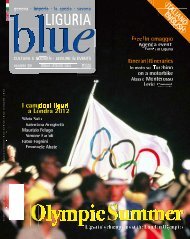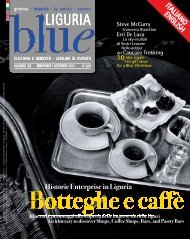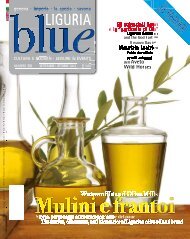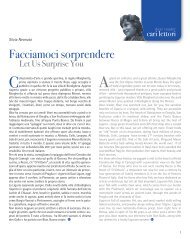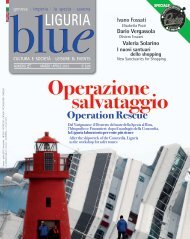Download PDF - Blue Liguria - Sagep
Download PDF - Blue Liguria - Sagep
Download PDF - Blue Liguria - Sagep
You also want an ePaper? Increase the reach of your titles
YUMPU automatically turns print PDFs into web optimized ePapers that Google loves.
anche nei loro successi reminiscenze, nostalgia e<br />
un mai sopito amore per lo Stivale Proseguendo<br />
il nostro piccolo viaggio musicale, diamo un<br />
metaforico “Oscar” di canzone-simbolo, in questa<br />
chiave, a un brano anch’esso eterno, fatto di<br />
semplicità melodica, di un’orecchiabilità che<br />
mette allegria e di un testo che punteggia la lingua<br />
americana con parole italiane divenute universali:<br />
è il 1952 quando si ascolta per la prima<br />
volta un valzerino elementare, con la sua brava<br />
“modulazione” prima di ripetersi per il finale e<br />
tanta fisarmonica in sottofondo a ricamare reminiscenze<br />
di sole e cieli azzurri: “That’s Amore”<br />
entra nel film “Occhio alla palla”, protagonista<br />
la coppia comica Dean Martin – Jerry Lewis, e<br />
nel giro di due anni diventa disco con propria dignità<br />
e fama imperitura, colonna sonora di altri<br />
film, di spot pubblicitari, di stacchi brevi o sigle,<br />
ogniqualvolta c’è da sintetizzare il bello del nostro<br />
canterino Paese.<br />
Con le origini centro meridionali di tutte queste<br />
star, sembrerebbe che Genova e la <strong>Liguria</strong> non<br />
abbiano trovato spazio nelle fortune canore dei<br />
propri emigranti. Niente di più falso. La mamma<br />
di Sinatra, “The Voice”, si chiamava Natalina Garaventa,<br />
e la sua famiglia era emigrata da Rossi di<br />
Lumarzo, entroterra genovese di Levante. E uno<br />
dei papà dello swing italiano, Natalino Otto, per<br />
anni ha fatto avanti e indré tra Sampierdarena e<br />
gli Stati Uniti per portarci dischi “clandestini” e<br />
riproporci il quasi jazz che conquistò l’Italia. O<br />
ancora la formazione statunitense del genovese<br />
Rino “Joe” Sentieri, chansonnier sui transatlantici<br />
fino a fermarsi negli Usa per “imparare” e poi<br />
tornare e trionfare a Sanremo, a Canzonissima e<br />
in tanti film.<br />
Già, il “tornare”. Cioè il tema della canzone-simbolo<br />
di Genova, la “Ma se ghe penso” in lingua<br />
genovese, intraducibile nella sua sonorità anche<br />
di vocaboli, nata con Mario Cappello e poi fatta<br />
diventare internazionale dalla grande Mina. Certo,<br />
qui il protagonista aveva fatto fortuna in Sud<br />
America, dove si concentrò gran parte degli emigranti<br />
genovesi e liguri: lui dice al figlio «… tu<br />
sei nato e hai parlato spagnolo, ma io son genovese<br />
e non mi arrendo».<br />
Ma quel pensiero del ritorno, che tutti gli emigranti,<br />
dovunque fossero sbarcati, si tennero in<br />
caldo nel cuore, è stato forse tra le motivazioni<br />
inconsce che hanno fatto nascere brani che non<br />
possono invecchiare. Basti guardare il sorriso che<br />
sboccia sul volto del più “tecnologico” dei ragazzini,<br />
se soltanto gli arriva alle orecchie «When<br />
the moon hits your eye, Like a big Pizza pie, That’s<br />
amore…»<br />
appeased love for our country<br />
Carrying on with our little musical voyage, let’s give<br />
a metaphoric Oscar to a symbolic song. With this in<br />
mind we seek a song that has become eternal, made<br />
of a simple melody that catches your ear, that<br />
makes you happy, with a text in the American<br />
language that includes Italian words that have<br />
become universal. It was in 1952 when the little<br />
elementary waltz was first heard with it brave<br />
“modulation” before it repeated itself for the finale<br />
with lots of accordion in the background to remind<br />
listeners of a sunny land of blue skies. “That’s<br />
Amore” came from the movie, “The Caddy”, with the<br />
comic duo of Dean Martin and Jerry Lewis.<br />
Within two years it became a hit with its own<br />
dignity and everlasting fame, as well as the<br />
soundtrack for other movies, for commercials,<br />
for brief breaks or logos, and, once in a while,<br />
as the synthesis of the beauty of our<br />
singing country.<br />
With the central and southern<br />
origins of all these stars, it would<br />
seem that Genoa and <strong>Liguria</strong> did not<br />
find fortune in the songs of their own<br />
emigrants. Nothing could be less true.<br />
Frank “The Voice” Sinatra’s mamma, Natalina<br />
Garaventa emigrated with her family from<br />
Rossi di Lumarzo in the mountains behind the<br />
eastern coast of the Riviera. And the papà of<br />
Italian swing, Natalino Otto, spent years<br />
going back and forth between<br />
Sampierdarena and the United States<br />
transporting “contraband” records to repropose<br />
the almost-jazz that made<br />
waves in Italy.<br />
Or even the American training of<br />
Genoese Rino “Joe” Sentieri, singersongwriter<br />
on oceanliners who then<br />
stayed on in the U.S. to “learn”, and<br />
later came back to triumph at<br />
Sanremo, at Canzonissima, and in<br />
so many movies.<br />
cover blue<br />
1894<br />
Nasce da genitori liguri<br />
di Lumarzo, profondo entroterra<br />
genovese, Natalina Garaventa,<br />
madre di Frank Sinatra,<br />
"The Voice"<br />
Natalina Garaventa, mother of<br />
"The Voice" (Frank Sinatra) in 1894,<br />
the daughter of <strong>Liguria</strong>ns from<br />
Lumarzo, in the Genoese<br />
hinterlands<br />
69



